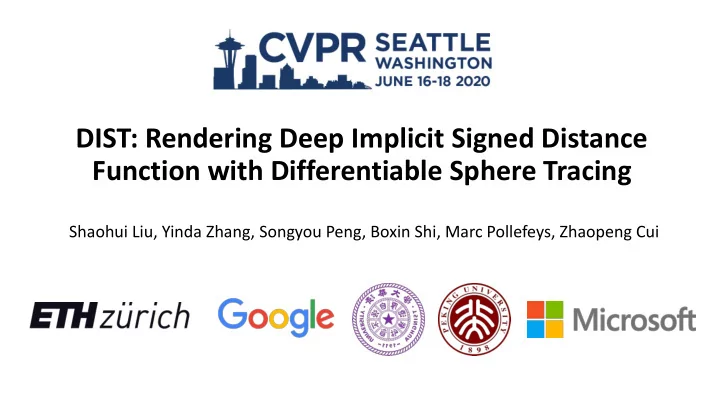

DIST: Rendering Deep Implicit Signed Distance Function with Differentiable Sphere Tracing Shaohui Liu, Yinda Zhang, Songyou Peng, Boxin Shi, Marc Pollefeys, Zhaopeng Cui
Deep Implicit Signed Distance Functions (DeepSDF) • Infinite-Resolution • Lightweight Voxel-based Representation DeepSDF Representation [Tatarchenko et al. ] [Park et al. ] No differentiable renderer for DeepSDF! Park et al. “DeepSDF: Learning Continuous Signed Distance Functions for Shape Representation”, In CVPR 2019.
Feedforward Rendering Results HR 2 nd View LR texture 32x HR texture HR Relighting
Optimization over Shape Code
DIST - Differentiable Sphere Tracing How to make feedforward efficient? What ray convergence criteria is the best setup? Gradient computation on the Efficient feedforward of rendered silhouette sphere tracing algorithm What can we do to resolve the GPU memory burden? How to deal with non-differentiable rendered silhouette?
DIST Feedforward – Naive Sphere Tracing For each camera ray, march along the ray direction at each step with the queried SDF value until convergence.
DIST Feedforward - Coarse-to-Fine Strategy We start the sphere tracing over an image with ¼ resolution, and split each ray twice during the marching process, which saves computation at the early stage.
DIST Feedforward – Aggressive Marching Setting step size α > 1 Setting step size α > 1 incurs speeds up convergence. bouncing between both sides.
DIST Feedforward – Convergence Criteria A large threshold ϵ causes We stop the marching once the dilation, while a small SDF value is smaller than 1/2 ϵ. threshold leads to erosion.
DIST Feedforward – Results The computation becomes affordable while the results remain almost unchanged.
DIST Backward – Recursive Gradients Each query location depends on the previous ones, incurring recursive gradients. Omitted This term is omitted as it empirically has less impact on the optimization process.
DIST Backward – Differentiable Silhouette Sphere Tracing min(abs(SDF)) min(abs(SDF)) < Є We make use of the nice property of signed distance function to optimize the nearest surface geometry.
Optimization over Camera Parameters Given a fixed shape, our differentiable renderer can successfully backpropagate gradients to the camera parameters with respect to 2D observations.
Results - Reconstruction from Sparse Depth Images 50% 10% Input DeepSDF Ours (w/o mask) Ours (w/ mask)
Results - Reconstruction from Video Sequences Synthetic #1 Synthetic #2 Lin et al. Lin et al. Ours Ours Real-world #1 Real-world #2 Lin et al. Lin et al. Ours Ours Lin et al, “Photometric Mesh Optimization for Video - Aligned 3D Object Reconstruction”, In CVPR 2019.
Code and Demo are available here http://b1ueber2y.me/projects/DIST-Renderer/
Full-Resolution: http://b1ueber2y.me/projects/DIST-Renderer/pdf/4986-poster.pdf
Recommend
More recommend